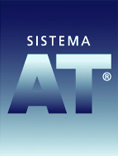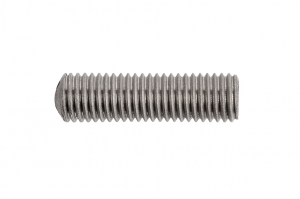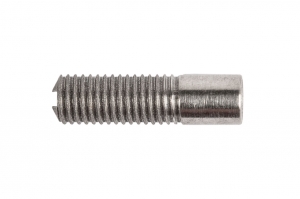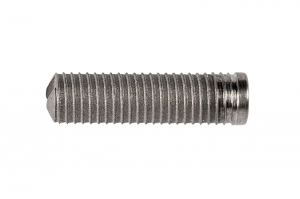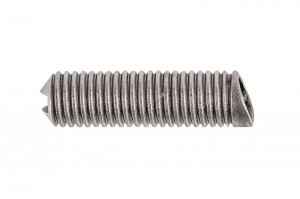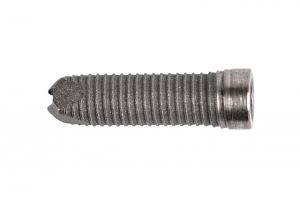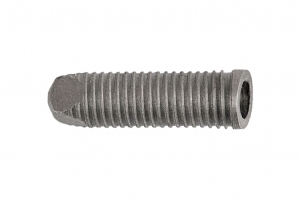Implants systems AT AT2 AT3
AT implants
The AT Implant System was developed by the Materials & Research Division as a universal system for resolving all cases of partial and complete edentulism, by replacing each missing root with an implant. All AT Implants are made of pure titanium to guarantee surface biocompatibility.
The upper margin of the implants can be modified using dedicated burs to obtain a full range of intermediate lengths, and to adapt it to the conformation of the bone crest, to avoid any type of protrusion.
AT Implants have an osteoinductive surface geometry, with microconcavities that favour the absorption of the serum proteins that act as growth factors by stimulating osteoblast activity.
This non-smooth occlusal margin gives AT Implants the advantage of having a greater contact surface area with the bone tissue.
Diameter 3,50 mm
| Implant length | Ref. code |
|---|---|
| 7 mm | 3024 |
| 10 mm | 3025 |
| 13 mm | 3026 |
| 16 mm | 3027 |
| 19 mm | 3028 |
| 22 mm | 3029 |
AT2 implants
AT2 implants have a smooth occlusal margin, which reduces bone resorption in patients with sub-optimum plaque control. They can also be left with the margin slightly above the bone crest, to reduce the damage to the periosteum and bone tissue at the time of exposure.
The implants’ narrow thread pitch and sand-blasted and acid-etched surface treatment increase the surface area of the titanium oxide-bone tissue interface by a factor of 5.
The blind internal bore with eccentric tip makes it possible to screw in the implants using the inserters as internal screwdrivers, and to cement the transmucosal component with eccentric tip for rotational stability once tissue integration has been achieved.
Diameter 3,45 mm
| Implant length | Ref. code |
|---|---|
| 7 mm | 3224 |
| 10 mm | 3225 |
| 13 mm | 3226 |
| 16 mm | 3227 |
| 19 mm | 3228 |
| 22 mm | 3229 |
AT3 grip implants
AT3 grip implants are a further evolution of the AT method and are characterised by a special surface treatment performed using a complex new blasting and etching technique that creates finer surface microroughness with an enhanced osteoinductive geometry.
This controlled surface enables greater fibrin and plasma protein adsorption to promote bone growth and allows more extensive and faster osteointegration than the other AT implants.
The smooth part of the upper margin of AT3 grip implants feature an original opacity treatment never used on implants before, using a special physical and chemical method that facilitates the stability of epithelial attachment by the hemidesmosomes of the peri-implant gingival margin.
This makes AT3 grip implants particularly well suited to immediate and early loading and cases in which the practitioner requires high osteointegration predictability and attachment stability in patients with sub-optimum oral hygiene.
Diameter 3,45 mm
| Implant length | Ref. code |
|---|---|
| 7 mm | 3421 |
| 8 mm | 3422 |
| 9 mm | 3423 |
| 10 mm | 3424 |
| 11 mm | 3425 |
| 12 mm | 3426 |
| 13 mm | 3427 |
| 14 mm | 3428 |
| 15 mm | 3429 |
| 16 mm | 3430 |
| 17 mm | 3431 |
| 18 mm | 3432 |
| 19 mm | 3433 |
| 20 mm | 3434 |
| 21 mm | 3435 |
| 22 mm | 3436 |
AT3 grip 20° implants
AT3 grip implants are a further evolution of the AT method and are characterised by a special surface treatment performed using a complex new blasting and etching technique that creates finer surface microroughness with an enhanced osteoinductive geometry.
This controlled surface enables greater fibrin and plasma protein adsorption to promote bone growth and allows more extensive and faster osteointegration than the other AT implants.
The smooth part of the upper margin of AT3 grip implants feature an original opacity treatment never used on implants before, using a special physical and chemical method that facilitates the stability of epithelial attachment by the hemidesmosomes of the peri-implant gingival margin.
This makes AT3 grip implants particularly well suited to immediate and early loading and cases in which the practitioner requires high osteointegration predictability and attachment stability in patients with sub-optimum oral hygiene.
Diameter 3,45 mm
| Implant length | Ref. code |
|---|---|
| 7 mm | 3441 |
| 8 mm | 3442 |
| 9 mm | 3443 |
| 10 mm | 3444 |
| 11 mm | 3445 |
| 12 mm | 3446 |
| 13 mm | 3447 |
| 14 mm | 3448 |
| 15 mm | 3449 |
| 16 mm | 3450 |
| 17 mm | 3451 |
| 18 mm | 3452 |
| 19 mm | 3453 |
| 20 mm | 3454 |
| 21 mm | 3455 |
| 22 mm | 3456 |
4P tapered AT3 implants
4P tapered AT3 implants represent the latest generation of the AT method and are characterised by enhanced primary stability due to the slight tapering of their margin and the greater self-tapping conformation of their tip.
The four levels present on the tip of 4P tapered AT3 implants provide a further aid during insertion.
They allow more effective self-tapping even when bone quality is poor and enable early stabilisation for even faster osteointegration, making them ideal for use in immediate loading settings.
Diameter from 3.50 mm to 3.80 mm
| Implant length | Ref. code |
|---|---|
| 7 mm | 3701 |
| 8 mm | 3702 |
| 9 mm | 3703 |
| 10 mm | 3704 |
| 11 mm | 3705 |
| 12 mm | 3706 |
| 13 mm | 3707 |
| 14 mm | 3708 |
| 15 mm | 3709 |
| 16 mm | 3710 |
| 17 mm | 3711 |
| 18 mm | 3712 |
| 19 mm | 3713 |
| 20 mm | 3714 |
| 21 mm | 3715 |
| 22 mm | 3716 |
4P tapered AT3 implants 20°
4P tapered AT3 implants represent the latest generation of the AT method and are characterised by enhanced primary stability due to the slight tapering of their margin and the greater self-tapping conformation of their tip.
The four levels present on the tip of 4P tapered AT3 implants provide a further aid during insertion.
They allow more effective self-tapping even when bone quality is poor and enable early stabilisation for even faster osteointegration, making them ideal for use in immediate loading settings.
Diameter from 3.50 mm to 3.80 mm
| Implant length | Ref. code |
|---|---|
| 7 mm | 3721 |
| 8 mm | 3722 |
| 9 mm | 3723 |
| 10 mm | 3724 |
| 11 mm | 3725 |
| 12 mm | 3726 |
| 13 mm | 3727 |
| 14 mm | 3728 |
| 15 mm | 3729 |
| 16 mm | 3730 |
| 17 mm | 3731 |
| 18 mm | 3732 |
| 19 mm | 3733 |
| 20 mm | 3734 |
| 21 mm | 3735 |
| 22 mm | 3436 |
This post is also available in: Italian
